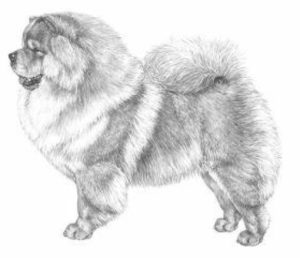Life’s Storm Chow Chow Kennel


ORIGIN: China
PATRONAGE: Great Britain.
DATE OF PUBLICATION OF THE OFFICIAL VALID
STANDARD: 13.10.2010.
UTILIZATION: Guard dog, companion
FCI–CLASSIFICATION:Group 5 Spitz and primitive type.
Section 5 Asian Spitz and related
breeds.
Without working trial.
BRIEF HISTORICAL SUMMARY: The ancestry of the Chow is
attributed to China where he was kept as a guard dog, and also used
for hunting. The Chow has been known in China for upwards of
2,000 years and is related to Spitz dogs of the Nordic type, also
containing something of the mastiff. Because of China’s ‘closed
door’ policy to the rest of the world Chows did not begin to appear in
other countries until around 1800. He made his way to England
sometime during the late eighteenth century and was not really
noticed in Britain until the 1920s, with a number being shown at
Crufts in 1925.
GENERAL APPEARANCE: Active, compact, short–coupled and
essentially well balanced, leonine in appearance, proud, dignified
bearing; well knit frame; tail carried well over back. Should always
be able to move freely and must not have so much coat as to
impede activity or cause distress in hot weather. A bluish–black
tongue is characteristic.
IMPORTANT PROPORTIONS: The distance from withers to
elbow is equal to the distance from elbow to ground.
FCI–St. N° 205 / 27.01.2011
3
BEHAVIOUR AND TEMPERAMENT: Quiet dog, good guard.
Independent, loyal, yet aloof.
HEAD
CRANIAL REGION:
Skull: Flat, broad.
Stop: Not pronounced.
FACIAL REGION:
Nose: Large and wide in all cases, black (with exception of cream
and near white, in which case a lighter coloured nose is permissible,
and in blues and fawns a self–coloured nose (but black preferable
in all cases).
Muzzle: Moderate in length, broad from eyes to end (not pointed at
end like a fox). Well filled out under the eyes.
Lips: A solid black mouth including the roof and flews, with a
bluish black tongue is ideal. However, some dilution may be
evident in the gums of blues and fawns and this dilution may be
more pronounced in creams and whites.
Jaws / Teeth: Teeth strong and level, jaws strong, with a perfect,
regular and complete scissor bite, i.e. the upper teeth closely
overlapping the lower teeth and set square to the jaws.
EYES: Dark, oval shaped, medium sized and clean. A matching
coloured eye permissible in blues and fawns. Clean eye, free from
entropion, never being penalised for sake of mere size.
EARS: Small, thick, slightly rounded at tip, carried stiffly and wide
apart but tilting well forward over eyes and slightly towards each
other, giving peculiar characteristic scowling expression of the breed.
Scowl never to be achieved by loose wrinkled skin of head.
NECK: Strong, full, not short, set well on shoulders and slightly
arched. Of sufficient length to carry the head proudly above the
topline.
BODY:
Back: Short, level and strong.
FCI–St. N° 205 / 27.01.2011
4
Loin: Powerful.
Chest: Broad and deep. Ribs well sprung, but not barrelled.
TAIL: Set high, carried well over back.
LIMBS
FOREQUARTERS:
Shoulder: Muscular and sloping.
Elbow: Equidistant between withers and ground.
Forearm: Perfectly straight, with good bone.
Forefeet: Small, round, cat–like, standing well up on toes.
HINDQUARTERS:
General appearance: In profile the foot is directly under the hip
joint.
Thigh: Well developed.
Stifle (Knee): Only slight bend.
Lower thigh: Well developed.
Metatarsus (Rear pastern): Hocks well let down. From hocks
downwards to appear straight, never flexing forward.
Hind feet: Small, round, cat–like, standing well up on toes.
GAIT / MOVEMENT: Relatively short striding, hind feet not
lifted high, appearing to skim the ground, resulting in pendulum
like action when seen in profile. Its distinctive short–striding gait
allows it to move freely, never lumbering and with excellent
endurance. Forelegs and hindlegs moving parallel to each other and
straight forward. Dogs should always be able to move freely and
soundly without any sign of distress.
COAT:
Hair: Either rough or smooth.
Rough: Profuse, abundant, dense, straight and stand–off but not
excessive in length. Outer coat coarse, with soft woolly undercoat.
Especially thick round neck forming mane or ruff and with good
culottes or breechings on back of thighs.
FCI–St. N° 205 / 27.01.2011
5
Smooth: Coat short, dense, straight, upstanding, not flat, plush–like in
texture.
Any artificial shortening of the coat which alters the natural outline
or expression should be penalised, with the exception of feet which
may be tidied.
Colour: Whole coloured black, red, blue, fawn, cream or white,
frequently shaded but not in patches or parti–coloured (underpart of
tail and back of thighs frequently of a lighter colour).
SIZE:
Height at the withers: Males: 48 – 56 cms.
Females: 46 – 51 cms.
FAULTS: Any departure from the foregoing points should be
considered a fault and the seriousness with which the fault should be
regarded should be in exact proportion to its degree and its effect
upon the health and welfare of the dog.
DISQUALIFYING FAULTS
• Aggressive or overly shy.
• Any dog clearly showing physical or behavioural
abnormalities.
N.B.:
• Male animals should have two apparently normal testicles
fully descended into the scrotum.
• Only functionally and clinically healthy dogs, with breed
typical conformation should be used for breeding.
The latest amendments are in bold characters.